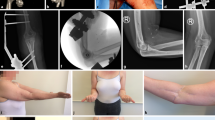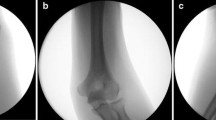Abstract
Background
Open elbow dislocations are rare injuries. Most of the evidence related to these dislocations is found in case reports or in series with closed injuries. We reviewed the experiences of three centers in the treatment of open elbow dislocations.
Question/purposes
We compared the results after operative treatment of simple and complex open dislocations in terms of (1) ROM, (2) functional score, and (3) complications.
Methods
Eighteen patients were retrospectively included in this study: 11 with simple open elbow dislocations and seven with complex open elbow dislocations. Mean age was 40 years. Thirteen were men. Eight patients presented neurovascular injuries. Evaluation included ROM of the elbow and forearm as measured by hand-held goniometer. We then classified the results using the 100-point Broberg and Morrey functional rating index based on ROM, grip strength, elbow stability, and pain. Scores of 95 to 100 were considered excellent, 80 to 94 good, 60 to 79 fair, and less than 60 poor. Complications were recorded. Minimum followup was 6 months (mean, 25 months; range, 6–72 months).
Results
We found no differences between simple and complex open elbow dislocations related to ROM (median flexion/extension: 117° versus 110°, p = 0.12; forearm rotation: 160° versus 170°, p = 0.67). According to the Broberg and Morrey score, four patients had excellent results, five good, and one fair in the simple dislocation group, whereas in the complex dislocation group, four patients had excellent results, two good, and one fair (p = 0.8). No difference in complication rate was found between groups (p = 0.63). All complications in the simple dislocation group were neurovascular. In the complex dislocation group, there was one case of brachial artery occlusion, two cases of heterotopic ossification, one case of infection and nonunion, and one case of infection. No patients had recurrent elbow instability.
Conclusions
No differences between simple and complex open elbow dislocations were found in terms of ROM, functional results, and rate of complications. Complications in the simple dislocation group were related to neurovascular injuries in contrast to the complex dislocation group where complications were associated with the bony injury.
Level of Evidence
Level IV, prognostic study. See Instructions for Authors for a complete description of levels of evidence.


Similar content being viewed by others
References
Ahmad R, Ahmed SM, Annamalai S, Case R. Open dislocation of the elbow with ipsilateral fracture of the radial head and distal radius: a rare combination without vascular injury. Emerg Med J . 2007;24:860.
Alonso JA, Roy BR, Shaw DL. Open antero-lateral dislocation of the elbow: a case report. BMC Musculoskelet Disord. 2002;3:1.
Anakwe RE, Middleton SD, Jenkins PJ, McQueen MM, Court-Brown CM. Patient-reported outcomes after simple dislocation of the elbow. J Bone Joint Surg Am. 2011;93:1220–1226.
Ayel JE, Bonnevialle N, Lafosse JM, Pidhorz L, Al Homsy M, Mansat P, Chaufour X, Rongieres M, Bonnevialle P. Acute elbow dislocation with arterial rupture: analysis of nine cases. Orthop Traumatol Surg Res. 2009;95:343–351.
Bachoura A, Guitton TG, Smith RM, Vrahas MS, Zurakowski D, Ring D. Infirmity and injury complexity are risk factors for surgical-site infection after operative fracture care. Clin Orthop Relat Res. 2011;469:2621–2630.
Bachy M, Leroux J, Pegot A, Abu Amara S, Lechevallier J, Bachy B. [Open elbow dislocation with distal ischemia: a therapeutic emergency] [in French]. Arch Pediatr. 2012;19:624–627.
Black N. Why we need observational studies to evaluate the effectiveness of health care. BMJ. 1996;312:1215–1218.
Broberg MA, Morrey BF. Results of delayed excision of the radial head after fracture. J Bone Joint Surg Am. 1986;68:669–674.
Collins DN, Temple SD. Open joint injuries: classification and treatment. Clin Orthop Relat Res. 1989;243:48–56.
Forthman C, Henket M, Ring DC. Elbow dislocation with intra-articular fracture: the results of operative treatment without repair of the medial collateral ligament. J Hand Surg Am. 2007;32:1200–1209.
Gustilo RB, Anderson JT. Prevention of infection in the treatment of one thousand and twenty-five open fractures of long bones: retrospective and prospective analyses. J Bone Joint Surg Am. 1976;58:453–458.
Henderson RS, Robertson IM. Open dislocation of the elbow with rupture of the brachial artery. J Bone Joint Surg Br. 1952;34:636–637.
Hildebrand KA, Patterson SD, King GJ. Acute elbow dislocations: simple and complex. Orthop Clin North Am. 1999;30:63–79.
Josefsson PO, Johnell O, Wendeberg B. Ligamentous injuries in dislocations of the elbow joint. Clin Orthop Relat Res. 1987; 221:221–225.
Josefsson PO, Nilsson BE. Incidence of elbow dislocation. Acta Orthop Scand. 1986;57:537–538.
Kilburn J, Sweeney JG, Silk FF. Three cases of compound posterior dislocation of the elbow with rupture of the brachial artery. J Bone Joint Surg Br. 1962;44:119–121.
Lansinger O, Karlsson J, Korner L, Mare K. Dislocation of the elbow joint. Arch Orthop Trauma Surg. 1984;102:183–186.
Martin DJ, Fazzi UG, Leach WJ. Brachial artery transection associated with closed and open dislocation of the elbow. Eur J Emerg Med. 2005;12:30–32.
Mehlhoff TL, Noble PC, Bennett JB, Tullos HS. Simple dislocation of the elbow in the adult: results after closed treatment. J Bone Joint Surg Am. 1988;70:244–249.
Morrey BF, An KN. Stability of the elbow: osseous constraints. J Shoulder Elbow Surg. 2005;14:174S–178S.
Pugh DM, Wild LM, Schemitsch EH, King GJ, McKee MD. Standard surgical protocol to treat elbow dislocations with radial head and coronoid fractures. J Bone Joint Surg Am. 2004;86:1122–1130.
Ring D, Jupiter JB. Fracture-dislocation of the elbow. J Bone Joint Surg Am. 1998;80:566–580.
Ring D, Jupiter JB, Zilberfarb J. Posterior dislocation of the elbow with fractures of the radial head and coronoid. J Bone Joint Surg Am. 2002;84:547–551.
Stoneback JW, Owens BD, Sykes J, Athwal GS, Pointer L, Wolf JM. Incidence of elbow dislocations in the United States population. J Bone Joint Surg Am. 2012;94:240–245.
Wiggers JK, Helmerhorst GTT, Brouwer KM, Niekel MC, Nunez F, Ring D. Injury complexity factors predict heterotopic ossification restricting motion after elbow trauma. Clin Orthop Relat Res. 2013. doi:10.1007/s11999-013-3304-0.
Author information
Authors and Affiliations
Corresponding author
Additional information
Each author certifies that he or she, or a member of his or her immediate family, has no funding or commercial associations (eg, consultancies, stock ownership, equity interest, patent/licensing arrangements, etc) that might pose a conflict of interest in connection with the submitted article.
All ICMJE Conflict of Interest Forms for authors and Clinical Orthopaedics and Related Research ® editors and board members are on file with the publication and can be viewed on request.
Each author certifies that his or her institution approved the human protocol for this investigation, that all investigations were conducted in conformity with ethical principles of research, and that informed consent for participation in the study was obtained.
The study was performed reviewing data from the medical records of the three institutions: Hospital Italiano de Buenos Aires (Buenos Aires, Argentina), Clínica de Fracturas y Ortopedia (Mar del Plata, Argentina), and Massachusetts General Hospital (Boston, MA, USA).
About this article
Cite this article
Boretto, J.G., Rodriguez Sammartino, M., Gallucci, G. et al. Comparative Study of Simple and Complex Open Elbow Dislocations. Clin Orthop Relat Res 472, 2037–2043 (2014). https://doi.org/10.1007/s11999-014-3491-3
Published:
Issue Date:
DOI: https://doi.org/10.1007/s11999-014-3491-3




